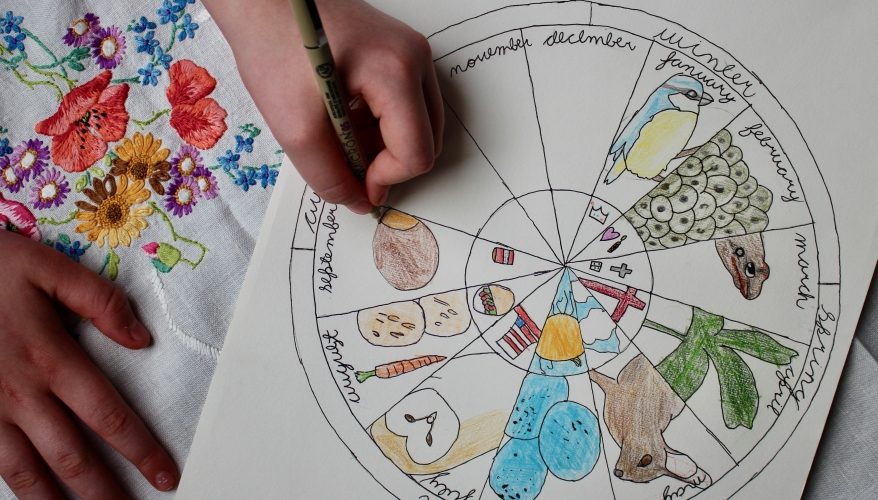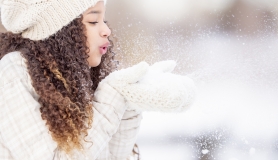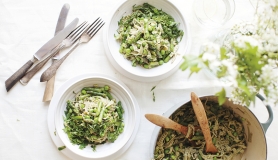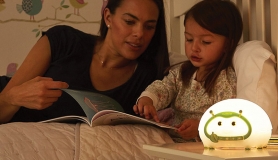“LOOK, MUM, THERE ARE black bees buzzing everywhere,” my then four-year old said, drawing my attention to a dark cloud of insects. I adjusted the newborn strapped to my chest and grabbed the hand of my three-year-old to watch the silvery-black Ashy Mining Bees streaming from a hole in the ground. It was the end of their hibernation, their first foray into daylight and we were there to bear witness.
This was the earliest miracle of the wild we recorded in our nature journals at the start of our home education journey. The watery black squiggles with spidery legs are illegibly labelled, but they mark the opening page of a book featuring bullfinches, knapweed, yellow brain fungus and Chinese witch hazel, to name a few.
Research tells us that both adults and children are suffering from what has been termed ‘Nature Deficit Disorder’. In 2008, a National Trust survey showed that half of the children interviewed were unable to tell the difference between a bee and a wasp. Last year, an RSPB Birdwatch Survey revealed that of 2000 adults, half could not identify a sparrow and a quarter did not know a blue tit or a starling. The same study, however, showed that 90% of parents wanted their children to be better educated about British wildlife.
Although I grew up in the countryside with great freedom to explore the rivers and fields that surrounded our home, my literacy of the natural world was limited. When my eldest child was at the stage of naming and categorizing everything, I answered, ‘tree’, ‘bird’, ‘flower’ to his questions. Now, as I have come to appreciate the endless possibilities of learning outdoors, my own vocabulary is expanding. When my one-year-old points at a bird we now say ‘great tit’, when he bends down to smell a wildflower my daughter tells him it is dog violet and is odourless. With the help of field guides, poetry and quality literature we are mapping out our natural territory with names and information that help us to make sense of it.
LOST WORDS Columnist, George Monbiot, believes that “Language is crucial to how we perceive the natural world”. He writes that “those who name it own it”. If we encourage our children to name the birds, trees, wild grasses and mushrooms, we invite them to take responsibility for their wellbeing. We are communicating that the natural world is of great relevance to their lives: they can play in it, celebrate it, learn from it and fight for it. This is important considering that Britain is considered to be “among the most nature depleted countries in the world” according to the 2016 State of Nature Report.
One of the most beautiful books on our bookshelf is ‘The Lost Words: A SpellBook’ by Robert McFarlane and artist, Jackie Morris. It is a magical collection of beautifully-illustrated spells that seek to conjure the words that are disappearing from our vocabulary and the species disappearing from their natural habitats. Each spell starts with an acrostic that my children decipher and read aloud, summoning adders and otters and weasels from the page. I then read the spell while they pour over the pictures and just like that we are part of the process of reclaiming what is being lost.
STARLING STORY
We recently travelled into Belfast to watch a magnificent starling murmuration over the Albert Bridge. The children stood with mouths agape as the birds dipped towards the river in perfect formation then broke ranks to form two sides of a heart. There were moments when the noise of the traffic faded and we could hear the wind of their wing beats and then all at once, they were gone. The reason we sought out such a display was because starlings nest in the eaves of our barn and last year we were able to chart their growth from tiny blue egg to fledgling. We studied everything from their nesting habits to their anatomy. We watched the male birds singing at the entrance to their newly built nests, enticing females to add their finishing touches. My daughter brought countless pieces of their discarded egg shells inside and tried to piece them together. We took video footage of the tiny open beaks of newly hatched birds and the children laid worm offerings on the tarmac beneath the nests.
We also drew a large red box beside our journal sketch of the bird. It marks its conservation status as a species under threat. To watch what McFarlane dubs the ‘Ghostly swirling surging whirling melting murmuration of starling flock’ was the conclusion of last year’s starling story: a story of new life, hope and the incredible synchronized dance of which they can be a part, if the fledglings make it to adulthood. The starlings tell part of our story too. We are relative newcomers to home education. For the first few months we spent long days on our smallholding trying to work out what it was going to look like for us. The ‘Rooftop riprap streetsmart hip-hop of starling song’ got our attention and studying the natural world became what we loved to do most. Those birds with their slick, paintsmattered feathers were perched on the powerlines of our house long before we moved in. Now, when my daughter goes out to feed the chickens she calls out to them by name and the spell is complete.
GREAT ORIGINAL ADVENTURE In his essay, ‘Manhood for Amateurs: The Wilderness of Childhood’ Michael Chabon writes that “People read stories of adventure – and write them – because they have themselves been adventurers”. He goes on to say that “childhood is… the great original adventure, a tale of privation, courage… and sometimes calamity”. So many of the stories I read aloud feature children with great freedom to explore and have adventures. They are the stories I too was raised on: The Famous Five, The Chronicles of Narnia, Swallows and Amazons, Alice in Wonderland. Allowing children to have access to wild spaces where they can get lost in their own imaginations provides opportunities to learn that are incomparable to indoor alternatives.
For us, it is not just about running free in the great outdoors, although this is definitely part of the experience. It is about connection. Dr. William Bird stated in the Outdoor Nation Interview that people are missing out on “something really fundamental, a connection with the rest of life”. One of the practices we employ as part of our outdoor learning is a Sit Spot. The idea is to find a place to be still and closely observe the environment while paying attention to the five senses. My children climb a tree or hide in the long grass and often return with tales of a spider web covered in dew drops or the call and response of a pair of buzzards. The benefit of this sort of practice is to learn how to be present. They are given permission to loiter beside a ladybird and count its spots before it takes flight. They are encouraged to push through the boredom of having nothing to do with their hands but rub them on the tree bark and marvel at its texture. As Dr. Vanessa Lapointe writes: “Children need to sit in their own boredom for the world to become quiet enough that they can hear themselves.” Only then can an original adventure be birthed.
SOME PRACTICAL TIPS
Whether you are a home educator, you have pre-school aged children or your children are at school, nature study is something you can integrate into your weekly or monthly rhythm. I have built up a collection of second hand field guides over the past year. We have one for everything from foraging to identifying animal tracks to a comprehensive guide to flowers that grow wild. My children love finding ‘treasure’ that we can identify. Some days we move slowly through our landscape, stopping to observe, name and learn about everything we find. Other days they are too busy chasing butterflies and fighting oak trees with stick swords so I take photographs of the things we see to identify them later.
The natural conclusion of nature study for us is recording our findings in a journal. In the spirit of honesty, I am not a very gifted artist. However, sitting at the table and learning to draw alongside my children has been as rich an experience for me as it has been for them. We cover the table with our nature findings, field guides, nature study handbooks and art supplies and attempt to capture the essence of the object on the page. We label our diagrams, record interesting facts about the species and experiment with different artistic techniques.
The other very simple way to support nature study is through books. When we’re learning about a particular animal, bird, plant or natural phenomenon we head to the library and gather all the picture books, chapter books and poetry we can find on the topic. Reference books are a helpful resource for parents and older children when studying nature, but for younger children the power of a good story does wonders to bring creatures and landscapes to life. My daughter calls every spider she meets ‘Charlotte’ and my son can still recite the dietary habits of The Hungry Caterpillar from memory. Time spent outdoors with the sun on their faces or the cold nipping their fingers brings my children to life in a way that is unique. They are free to be themselves. My son knocks pine cones from their highest boughs and digs in the dirt until mud is lodged so deeply beneath his fingernails that I have no hope of getting it out. My daughter swings on rhododendron branches, discovers mushrooms in the leaf mold and fills her pockets with interesting objects. My toddler potters in the grass and learns how to find his feet on the varied terrain. Outside we are better connected with nature, our fellow creatures and one another. In the words of fellow naturalist Henry David Thoreau, ‘All good things are wild and free’.
MORE INSPIRATION
READ We love the Pan Original series by Roger Phillips incorporating Trees, Wild Flowers, Wild Food and Lichens
EXPLORE Bethany’s blog at bethanyjoydawson.com/journal/
LEARN The beautiful phenology wheel used to illustrate this article is from Lynn Seddon’s RaisingLittleShoots.com - a year long curriculum for children who are fascinated by the natural world.
MARCI GOODWIN OF THE HOMESCHOOL SCIENTIST (thehomeschoolscientist.com) SHARES HER TIPS FOR GETTING STARTED
1 DRAWINGS Drawing what you see in nature has two benefits. First, it slows you down enough to truly see. You can’t sketch something that you have not studied intently. Secondly, drawing provides a record of your nature excursion. Besides pencil sketches, try your hand at crayon rubbings (of leaves or bark, for example) or watercolour paintings. A budding photographer may choose to take pictures and include those in his nature journal. Carry a clipboard to provide a firm drawing surface and to keep papers from flying in the breeze. Or collect treasures to bring home for quiet sketching indoors.
2 NOTES Besides drawings, a nature journal is a great place for writing about what you saw. Here are some writing prompts for a nature journal: • What did you see? (Also hear, feel, and smell?) • What did you wonder about? • What surprised you? • What was the most beautiful thing you saw?
3 RESEARCH Children are naturally curious, and a nature walk can raise dozens of questions. This is why field guides are recommended. Your nature study will prod you to identify the names of creatures and plants as well as a few basic facts about them.
4 RECORD KEEPING Another valuable part of a nature journal is keeping records of your observations in a more formal way such as through charts or logs. These records may last an entire year and provide an awareness of the cycles of nature. • photograph and write about a tree all year long at predetermined points –maybe four times a year or each month • seasonal milestones –such as the first daffodil bloom, first snow, or first day of summer that reached 100 degrees • temperature and weather patterns – recording the amount of rainfall, daily temperatures, or cloud formations based on reading your own gauges and observing the sky.
5 CONNECTIONS You may study nature in art or music inspired by nature or poems about nature. Obviously, science will often feature in your nature journal as you follow your children’s interests to explore geology, botany, entomology, and so on. There may even be historical topics that connect to your nature studies. You can write about any of these in a nature journal.







